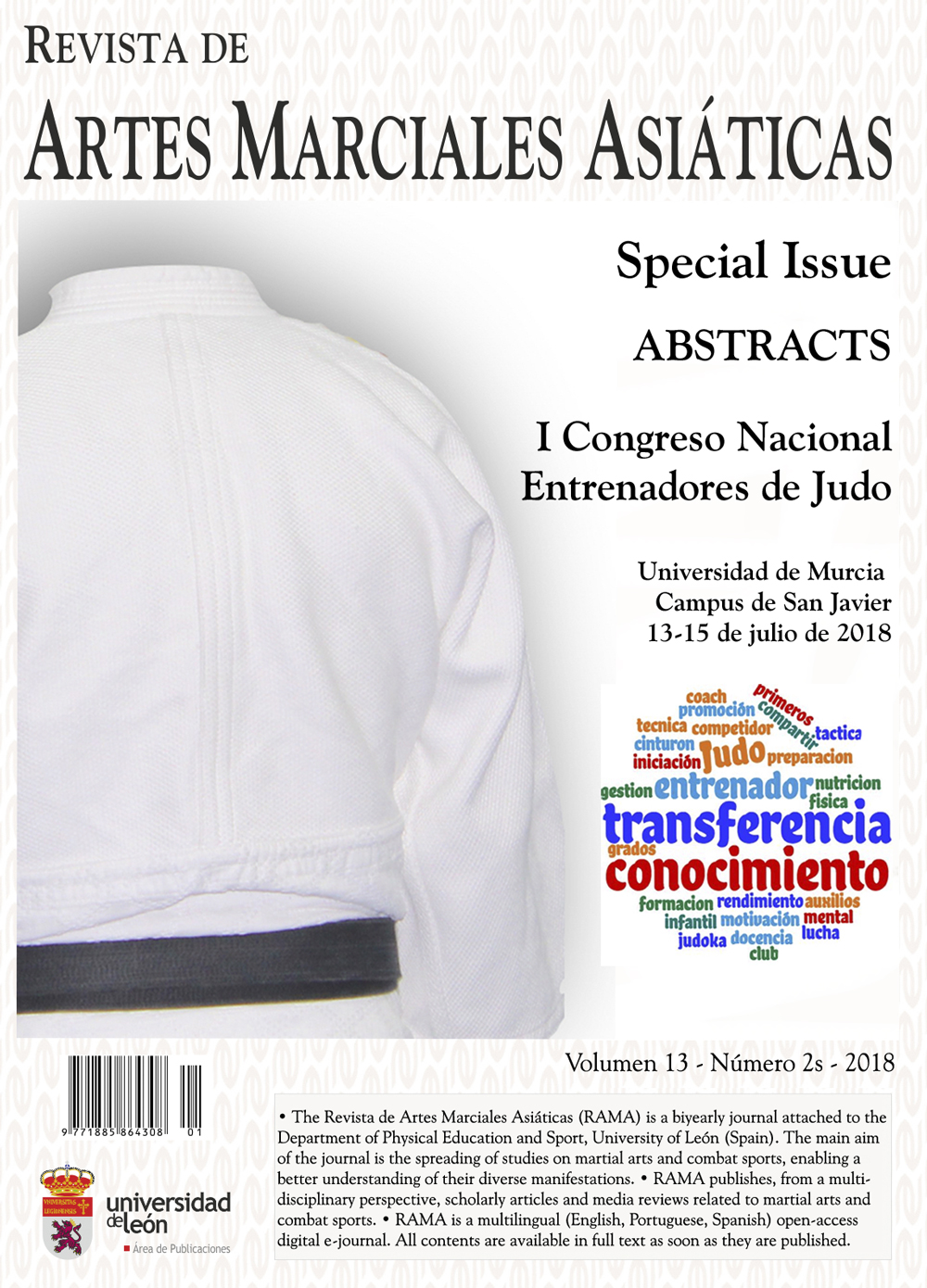Valoración funcional básica del judoka: un estudio piloto
DOI:
https://doi.org/10.18002/rama.v13i2s.5500Palabras clave:
Judo, estabilidad, movilidad, valoración funcionalResumen
El objetivo del presente estudio fue describir el Perfil Funcional Básico (VAFB) de un grupo de 13 judokas competidores a nivel nacional. Se utilizó la batería Valoración Funcional Básica propuesta por Gil-López (2018). Los datos obtenidos indican un Índice Global de Riesgo de Lesión (IGRL) de 45,74±2,01%. Las compensaciones que más se han dado entre todos los judokas fueron rotación externa del pie derecho/izquierdo, pronación pie derecho/izquierdo, pérdida de disociación lumbo-pélvica, movimiento del tórax, escápulas aladas y protacción cervical. En cuanto, a los años de práctica se muestran diferencias en el test de la articulación del hombro (SM), donde aparece mayor número de compensaciones en los sujetos que llevan menos de diez años practicando judo. El grupo de judokas analizado no muestra un alto riesgo de lesión, pero se recomienda incluir un trabajo correctivo para la mejora de los déficits registrados.
Descargas
Métricas alternativas
Citas
Bolach, B., Witkowski, K., Piepiora, P., Sokólski, R., & Bolach, E. (2016). Injuries and overloads in combat sports exemplified by Thai boxing and judo. Journal of Combat Sports and Martial Arts, 2(2), 89-96.
Boguszewski, D., Adamczyk, J.G., Buda, M., Kłoda, M., & Białoszewsk, D. (2016). The use of functional tests to assess risk of injuries in judokas. Archives of Budo, 12, 56-62.
Boguszewski, D., Buda, M., Adamczyk, J.G., Boguszewska, K., Obszynska-Litwiniec, A., & Białoszewsk, D. (2014). Chronic pain in the musculoskeletal system among judo athletes. Journal of Combat Sports and Martial Arts, 2(2): 77-82.
Castropil, W., & Arnoni, C. (2014). Postural patterns and adaptations in judo athletes. Archives of Budo, 10, 23-28
Chapman, R. F., Laymon, A. S., & Arnald, T. (2014). Functional Movement Scores and Longitudinal Performance Outcomes in Elite Track and Field Athletes. International Journal of Sports Physiology and Performance, 9, 203-211. doi: http://doi.org/10.1123/ijspp.2012-0329
De Blaiser, C., Roosen, P., Willems, T., Danneels, L., Vanden, L., & De Ridder, R. (2018). Is core stability a risk factor for lower extremity injuries in an athletic population? A systematic review. Physical therapy in sport, 30, 48-56. doi: http://doi.org/10.1016/j.ptsp.2017.08.076
Detanico, D., dal Pupo, J., Franchini, E., Fukuda, D. H., & dos Santos, S. G. (2017). Effects of traditional judo training session on muscle damage symptoms. Journal of Sports Medicine and Physical Fitness, 57(6), 872-878. doi: http://doi.org/10.23736/S0022-4707.16.06320-9
Gil-López, M. I. (2018). Valoración Funcional Básica. Propuesta y justificación a través de la metodologia observacional (Trabajo de máster). Facultad ciencias del deporte, Universidad de Murcia, Murcia, España.
Hides, J. A., Oostenbroek, T., Smith, M. M. F., & Mendis, M. D. (2016). The effect of low back pain on trunk muscle size/function and hip strength in elite football (soccer) players. Journal of sports sciences, 34(24), 2303-11. http://doi.org/10.1016/j.jsams.2017.01.049
Descargas
Publicado
Cómo citar
Número
Sección
Licencia
Derechos de autor 2018 María Isabel Gil-López, Mateo García-Hurtado, Raquel Hernández-García

Esta obra está bajo una licencia internacional Creative Commons Atribución-NoComercial-CompartirIgual 4.0.
Los autores que publican en esta revista están de acuerdo con los siguientes términos:
- Los autores ceden de forma no exclusiva los derechos de explotación (reproducción, distribución, comunicación pública, transformación) a la Universidad de León, por lo que pueden establecer, por separado, acuerdos adicionales para la distribución no exclusiva de la versión de la obra publicada en la revista (por ejemplo, alojarlo en un repositorio institucional o publicarlo en un libro), con un reconocimiento de su publicación inicial en esta revista.
- Este trabajo se encuentra bajo la Creative Commons Attribution-NonCommercial-ShareAlike 4.0 International License. Puede consultarse desde aquí la versión informativa y el texto legal de la licencia.
- Se permite y se anima a los autores a difundir electrónicamente las versiones pre-print (versión antes de ser evaluada) y/o post-print (versión evaluada y aceptada para su publicación) de sus obras antes de su publicación, ya que favorece su circulación y difusión más temprana y con ello un posible aumento en su citación y alcance entre la comunidad académica.











